News
Simpler Form
Fuminao SUENAGA, Katsuhisa SATO, Momo YOSHINO, Riko KINOSHITA

Sticky Notes
2025
Paper, acrylic paint
8 x 9 x 0.6 cm

Kurari
2025
Acrylic on canvas
45.5 x 45.5 cm

Kami #94 – 2
2025
Acrylic on panel
59.5 x 59.5 cm

game
2025
Aluminum foil, acrylic paint, neodymium magnets
12.5 x 7.8 x 0.2 cm / 12.5 x 8.2 x 0.2 cm
12.7 x 7.8 x 0.2 cm / 10.8 x 7.7 x 0.2 cm









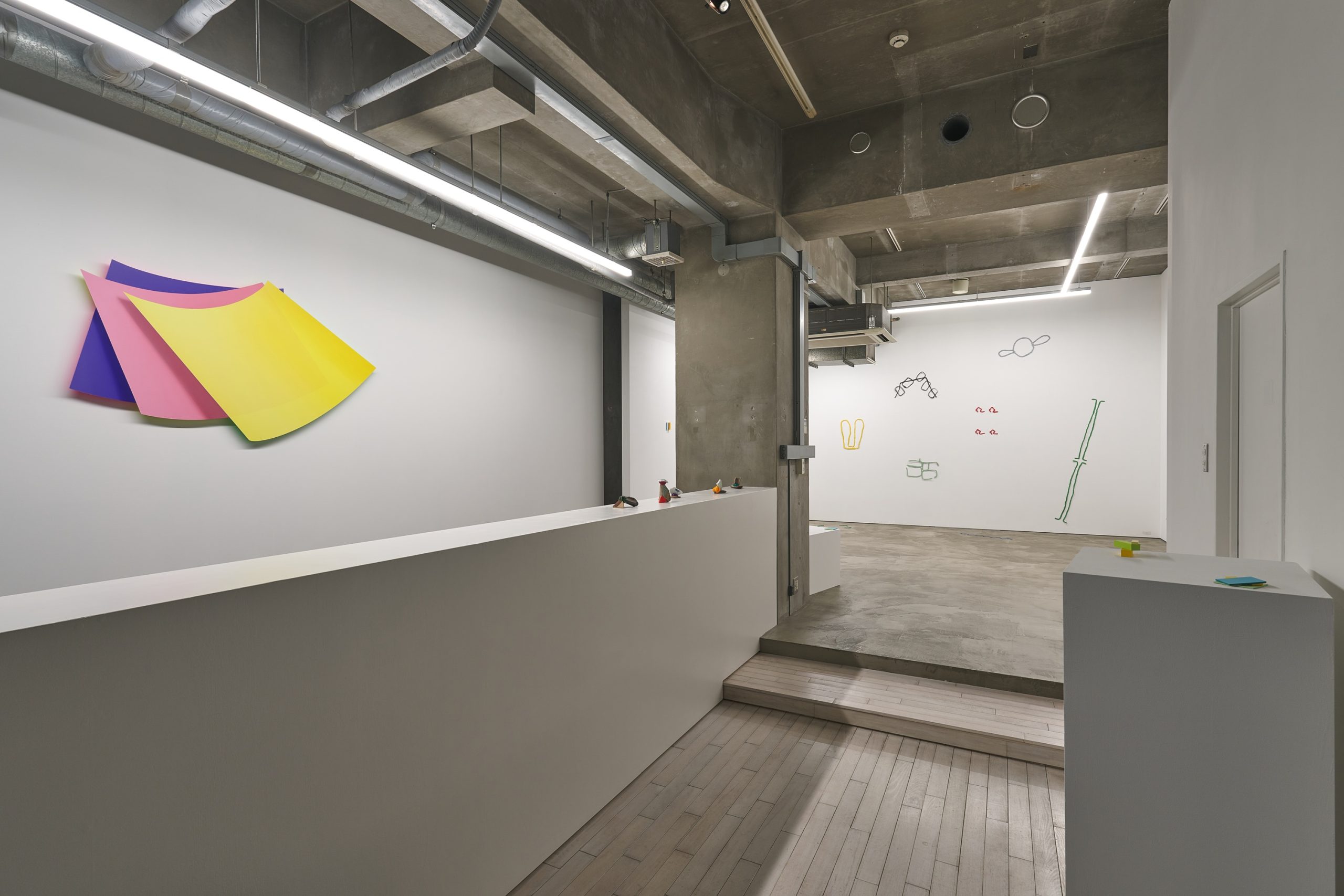


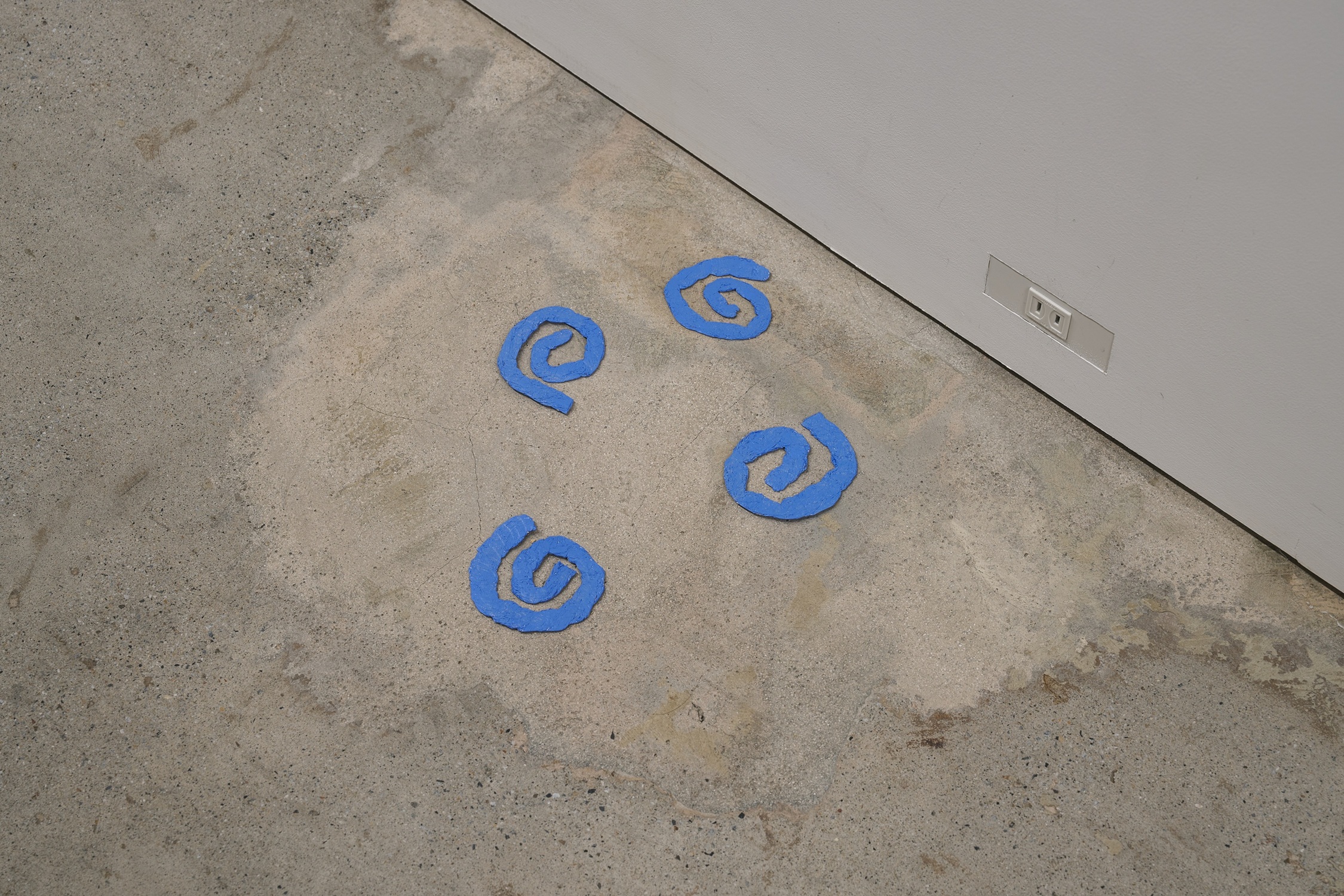
Abstractions – from a certain point –
Yasuko Toyoshima, Katsuhisa Sato, Fuminao Suenaga, Shoko Masunaga

The Copernican Theory_2020 Khanun
2020
Wood, natural paint, bolt and nut, flat washer
17.5 x 17.5 x 4.9 cm
Yasuko TOYOSHIMA
By taking a critical look at institutions and systems found in everyday life and in our society, Toyoshima focuses on creating works that shed light on the patterns found in human thought.
Born in 1967, Saitama, Japan. Toyoshima received her MFA from Tokyo University of the Arts. Recent shows include Origination Method (solo, Museum of Contemporary Art Tokyo, 2023-24), Group Show – Yasuko Toyoshima, Ryosuke Ogino, Makoto Ito (group, 2023-24, Maki Fine Arts), Enclosure(solo, M gallery, 2021), Alternating Current 2021(solo, Galleria Finarte, 2021), PUBLIC DEVICE – Symbolism and Permanence of Sculpture (group, The University Art Museum, Tokyo University of The Arts, Tokyo, 2020).

face to face
2019
Oil on canvas
65.2 x 53 cm
Katsuhisa SATO
Sato explores the relationship between color and form with humor, using the system and form of painting as his subject matter.
Born in 1973, Hiroshima, Japan. Sato received his MFA from Aichi Prefectural University of Fine Arts and Music. Recent shows include solo show (See Saw gallery+hibit, 2023), Same Thing (solo, SHINBI GALLERY, 2023), Insight 28 ”hang” (group, Yoshimi Arts, 2023), Collection Beginning – Multiverse / Cat (group, Toyota Municipal Museum of Art, 2023), SHOUONJI ART PROJECT 28th Katsuhisa Sato ”surface / ecafrus” (solo, SHOUONJI, 2021).

Search Results
2024
Acrylic, pigment on cotton, panel
42 x 69.5 cm
Fuminao SUENAGA
His paintings and three-dimensional works are based on visual subject matters inspired by elements relating to exhibition spaces and observations made during day-to-day activities.
Born in 1974, Yamaguchi, Japan. Suenaga graduated from Tokyo Zokei University in 1999 with a major in painting. Recent shows include UTSUSU (group, BOOK AND SONS, 2024), Textural Synthesis (group, Mitsukoshi Contemporary, 2024),Light paintings (solo, Maki Fine Arts, 2024), HEIHA (group, Gallery DEN5, 2023), Group Show – Yoshio Shirakawa | Fuminao Suenaga | Keisuke Shirota | Shunsuke Kano | Sean Micka (group, Maki Fine Arts, 2023).

session4
2023
Panel, canvas, acrylic, pencil
72.5 x 40 x 2 cm
Shoko MASUNAGA
Her creative process originates from paintings and utilizes a variety of techniques. By focusing on the connections to the surrounding environment and space, her works become fluid and interchangeable.
Born 1980 in Osaka, Japan, Shoko Masunaga graduated from Seian Zokei Junion College in 2001 with a degree in painting. Recent shows include MEMORIES (group, CADAN Yurakucho, 2023), Ginza Curator’s Room #005 Angel’s Perch (group, Shibunkaku Ginza, 2023), What Comes After the Beyond (solo, Maki Fine Arts, 2023), editing (solo, nidi gallery,2022), replace (solo, LOKO Gallery, 2021).
—
Abstractions – from a certain point –
Yasuko Toyoshima, Katsuhisa Sato, Fuminao Suenaga, Shoko Masunaga
Date : August 6 – 25, 2024
Venue : CADAN Yurakucho / Kokusai Building 1F, 3-1-1 Marunouchi, Chiyoda-ku, Tokyo
Open : Tuesday – Friday 11AM-7PM / Saturday, Sunday and National Holidays 11AM – 5PM
Closed : Mondays and Days following National Holidays
link



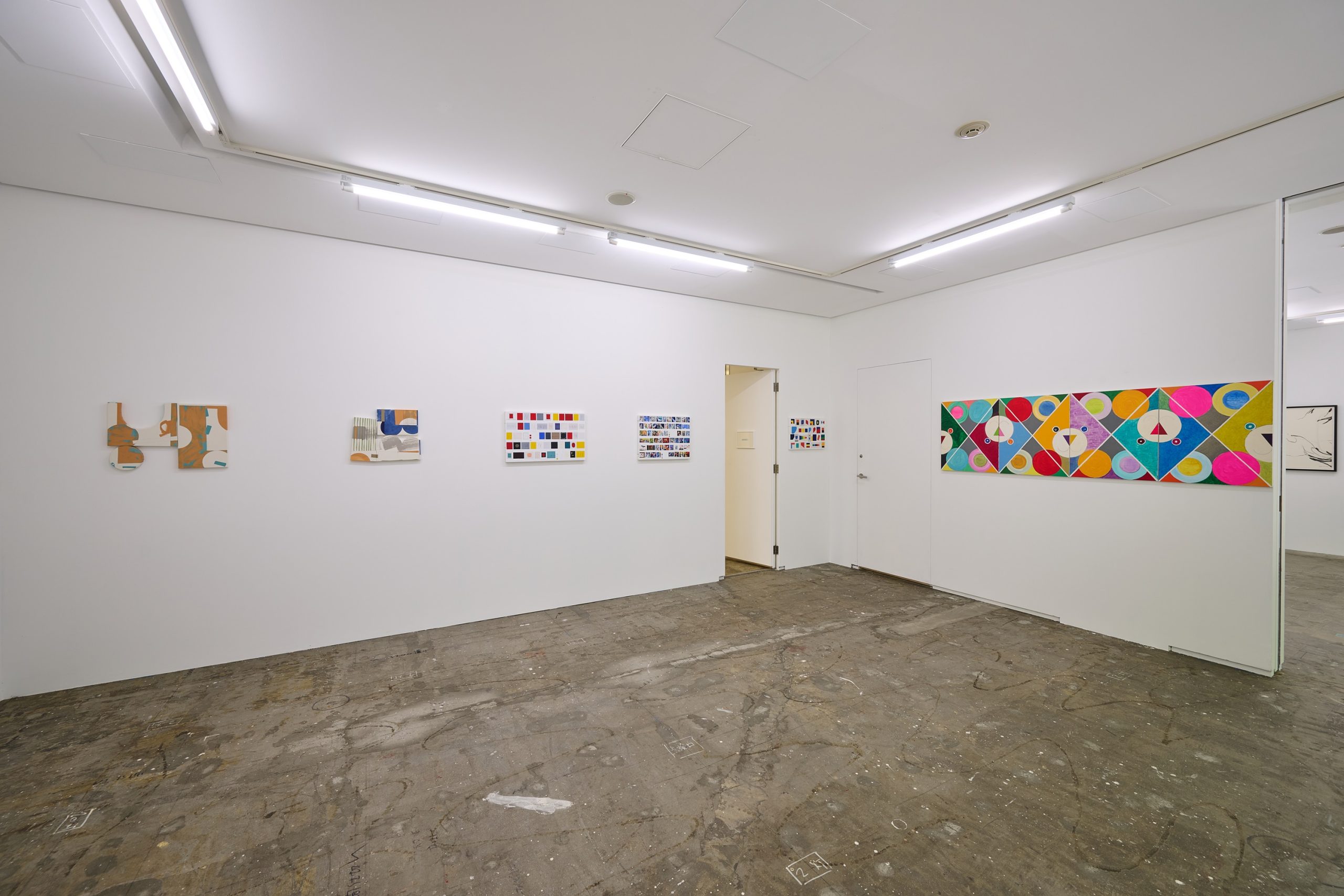








Fuminao Suenaga : Light paintings
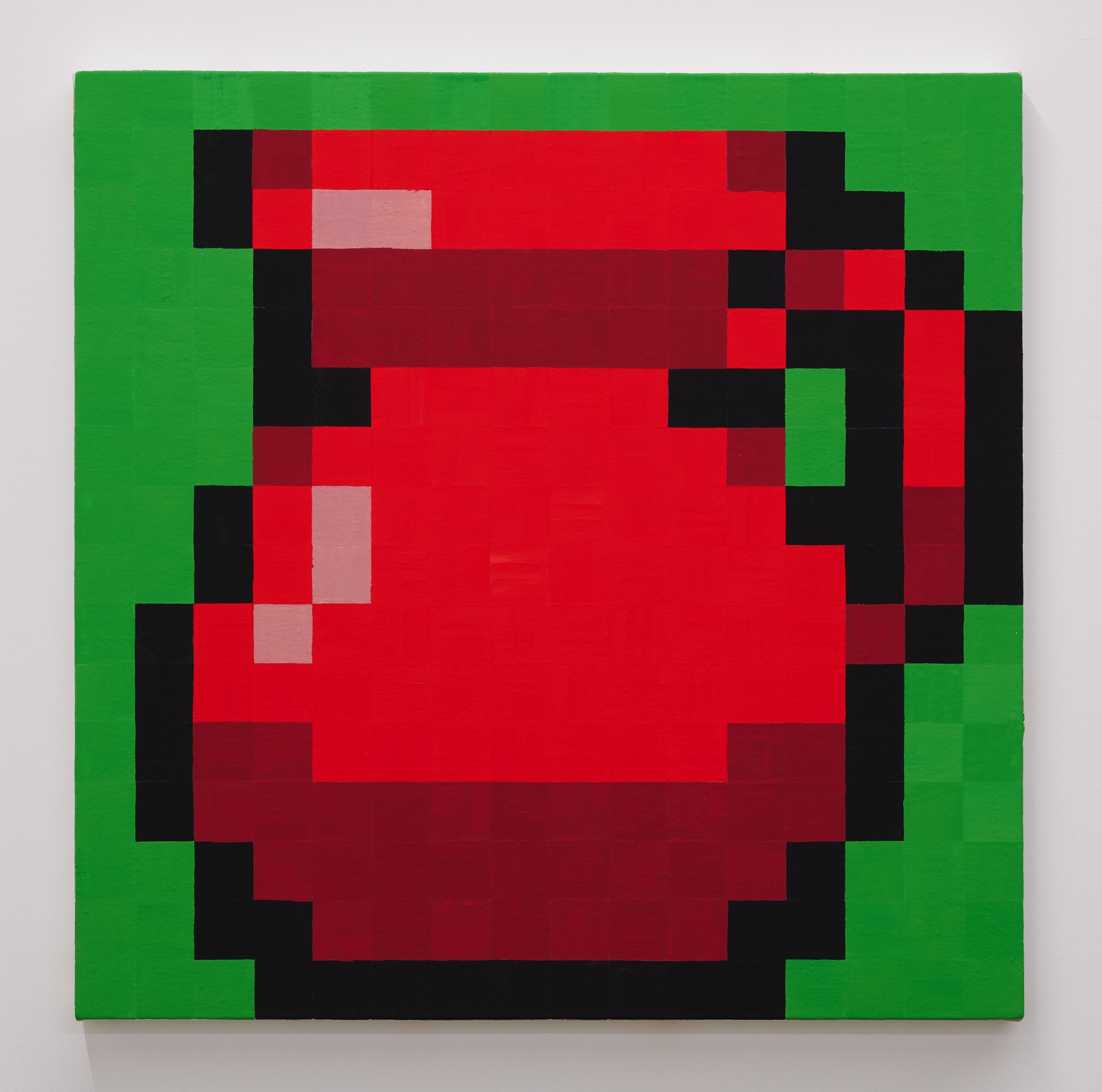
Red vase
2023
Acrylic, pigment on cotton, panel
60 x 60 cm

Auditorium
2023
Acrylic, pigment on cotton, panel
60 x 60 cm

Coin
2023
Acrylic, pigment on cotton, panel
30 x 30 cm
Maki Fine Arts is pleased to present Light paintings, a solo show by Fuminao Suenaga, from February 17 through March 17, 2024. This will be Suenaga’s fifth solo show since his last show at Maki Fine Arts three and a half years ago.
—
A Blow of Lightness—About Fuminao Suenaga’s Light painting show
Keisuke Mori, Chiba City Museum of Art curator
Fuminao Suenaga’s paintings—hand-stretched square canvases divided lengthwise and crosswise into squares of 8, 16, and 32 grids which are then colored individually—are geometric and abstract, yet they convey a certain unique iconography. As referenced by the artist himself, Suenaga uses pixel art (dot paintings) and an iPad in his production process. His works showcased in Light paintings certainly have a correlation with technology and digital devices, even if their resolution may be perceived as “low.” And for visitors of a specific generation, the red vase-like container, the flowers, the crowd, and the explosions laid out in the gallery may evoke nostalgic scenes from computer games and ignite a certain sentimentality.
This new evolution using the iPad, for example, could be pointed out as related to the artist’s earlier series “Search Results,” his pre-pandemic paintings which depicted internet image search results of 20th century modern master artists. Motifs chosen by the artis previously included everyday items found around the artist, such as Post-its, levels, and protective storage boxes. In addition, objects existing in front of the viewer, such as picture frames were used as motifs. In other words, if we take into account the fact that the reproduction or representation of the real word has been done through the production of paintings, then we can understand that even the shimmering paint details evoking the physicality of the works in his newest exhibition can be seen as a pictorialization recognized by the artist in which a luminescent display is included.
Thus, Suenaga’s production philosophy—which is based on the proposition of pictorialization or materialization of real subjects—is a maneuver related to transformation including reduction, compression, substitution, and repetition exercised in the process of abstraction. And therefore, inevitably, it takes on the aspect of a “simulacre” which approximates reality.* Since proximity between the work and the system of painting has been indicated before, these works too, should be read as a mimicry of pixel art and as the artist’s intention of hacking the system itself. In other words, in contrast to its overt expression, only in the symbolic operation of various codes can Suenaga’s paintings secure their existence. So, his works—using a square as a unit and intricately composed with nonlinear combinations of 64, 256, and 1024 color grids—not surprisingly summon many paintings from the past. From Gerhard Richter’s “color chart” to Paul Klee’s grid-like abstract paintings which indirectly influenced the title of his new show, Suenaga’s works elicits the possibility of connection to paintings from the past.
When the visual similarities between each work are casually consumed as excess symbols, however, it may instead cause to decrease the high-order nature of the strategy latent in Suenaga’s paintings. Richter referenced Marcel Duchamp’s readymades in the “color chart” paintings he began creating in 1966 and was strongly influenced by pop art after moving to West Germany. Suenaga has created paintings intended to be practical objects while suppressing its subjects. Roy Lichtenstein’s influence during Suenaga’s earlier artist years and his approach to the medium of print and the continuity to his use of modern digital devices of recent years necessitates us to examine the fine-mesh details of the relationships between the individual paintings and the paintings etched into art history.
Since starting his path at the end of the 20th century, Suenaga’s artistic journey is about to reach a quarter of a century. His method of production—where multiple media firmly connect to daily life and those complex information environments evolve across the board to materialize the real world—is inseparable from society, and thus seems to have continued to bear the postmodern syndrome that was strongly prevalent at the time his activities began. The lightness indicated in the title of this show is a characteristic that runs through all of Suenaga’s works. The significance and potential of such strategies running parallel to the age of globalism—such as the homogenization or flattening of information and the “lightness” or “smallness” which could be considered the consequence the usurpation of mass—should be examined in more detail. Just as his collection of minimal squares in this exhibition are a maneuver making it possible to link them not only to the multitude of paintings by other artists but to his works from the past, the archival nature frequently seen in recent years must be a highly important aspect for the viewer to understand his works. At least to this writer, these “light paintings” ask us to decode the symbols, while, as previously pointed out regarding the manifestation as a flat surface, they paradoxically provide a complex richness that refuses easy consumption. These works are a ferocious blow or stab equivalent to the weight of the history of the era that has predestined the works. And perhaps, it is the artist’s own ferocity which is felt.
*Simulacre is a concept proposed by French philosopher Jen Baudrillard. It refers to a cultural phenomenon in which replicated symbols saturating the consumer society results in the real world itself becoming symbolized and the perception of conventional things beginning to transform.
—
I admit that I find myself searching for coolness in artillery vehicles when I see them shown during news of war conflicts, even though I understand that it is inappropriate. The realization that the reason for such a thought may have stemmed from my childhood experience with video games became the jumping off point for this show.
Some of the images I created were taken from games while others were digital drawings pixelated by using a pixel drawing app on my iPad. In addition, some images taken from games were altered.
Regardless of which image was used as the original, I copied them while I had my iPad at my side displaying a digital draft of the pixel art. Since the colors seen in the luminescence of the display and the colors seen as a mixture of pigments and mediums differ in the way it is received, there was a step taken in the process to make substitutions and to reconstruct the relationship. When paint is applied by hand and brush, the boundaries between colors are blurred and shifted, creating subtle overflows. Also, although the painting may appear to be painted flat, traces of the brush’s tremor and pressure remain on the surface. The combination of several factors results in a modestly abstract image that is almost faithful to the original painting, but in a different way.
Fuminao Suenaga








Group Show – Yoshio Shirakawa | Fuminao Suenaga | Keisuke Shirota | Shunsuke Kano | Sean Micka

Search Results
2022
Acrylic, pigment on cotton, panel
48.5 x 63.5cm
Maki Fine Arts is pleased to present a group show featuring new and recent works by five artists starting Saturday, June 25, through Sunday, July 24, 2022.
Yoshio Shirakawa
Born 1948 in Fukuoka, Japan, Yoshio Shirakawa graduated from Kunstakademie Düsseldorf in 1981. Recent shows include To the Enneades (Rin Art Association, 2022), Summer Light (solo, Maki Fine Arts, 2019), Weavers of Worlds -A Century of Flux in Japanese Modern/Contemporary Art–(Museum of Contemporary Art Tokyo, 2019), Production Process (solo, Rin Art Association, 2018), Beyond the future of Meld Sculpture (curation, Maki Fine Arts, 2018), Creative Dialogue with Museum 01–MONUMENT (Tottori Prefecture Museum, 2017), Aichi Triennale 2016–A Rainbow Caravan (2016), The Capital Room: Beyond Three Dimensional Logical Pictures–vol. 7 (solo, gallery αM, 2016), and dada, dada, da (solo, Arts Maebashi, 2014).
Fuminao Suenaga
Born 1974 in Yamaguchi, Japan, Fuminao Suenaga graduated from Tokyo Zokei University in 1999 with a major in painting. Recent shows include Picture Frame (solo, Maki Fine Arts, 2020), Publicness of the Art Center (Art Tower Mito, Contemporary Art Gallery, 2019-2020), Weavers of Worlds–A Century of Flux in Japanese Modern/Contemporary Art– (Museum of Contemporary Art Tokyo, 2019), MOT Collection: Pleased to meet you. New Acquisitions in recent years (Museum of Contemporary Art Tokyo, 2019), Search Results (solo, Maki Fine Arts, Tokyo, 2018), railroad siding 2017 (former Tokorozawa city supply center for school meals, Saitama, 2017), APMoA Project ARCH vol. 11 Museum Piece (Aichi Prefecture Museum of Art, 2014), and Born in 1974 (part 1 of a 40th anniversary show, Museum of Modern Art, Gunma, 2014).
Keisuke Shirota
Born 1975 in Kanagawa, Japan, Keisuke Shirota received his MFA from Tokyo University of the Arts, Department of Design in 2003. His recent exhibitions include Out of the frame (solo, Maki Fine Arts, 2022), Over (solo, Maki Fine Arts, 2021), PAINT,SEEING PHOTOS (solo, Chigasaki City Museum of Art, 2019-2020), Tracing / Background (solo, Base Gallery, 2013), Shell Artist Selection (The National Art Center, Tokyo, 2013), Photo Reference: Photographic Image in Contemporary Japanese Art Practices (Belgrade Cultural Center, 2012), and his solo show at Galerie Stefan Röpke (2010).
Shunsuke Kano
Born 1983 in Osaka, Japan, Shunsuke Kano completed his graduate studies at Kyoto Saga University of Arts in 2010. Recent shows include Gaps in the Sandwich (solo, The Triangle, Kyoto City KYOCERA Museum of Art, 2021-2022), Cascades and Barriers (solo, Maki Fine Arts, 2021), Compression Training (solo, Clinic, 2021), Counter Program (solo, Art-Space TARN, 2020), Fountain for the 8th shiseido art egg (Shiseido Gallery, 2021), VOCA 2017 Vision of Contemporary Art (Ueno Royal Museum, 2017), and Photography Will Be (Aichi Prefectural Museum of Art, 2014). Kano is also a member of the COPY TRAVELLERS.
Sean Micka
Born 1979 in Boston, Massachusetts, Sean Micka lives and works in Brooklyn, New York. Micka was a participant in the Whitney Museum of American Art’s Independent Study Program from 2012-2013 and 2013-2014. Recent shows include, Fine Silver and Extraordinary Diamonds from the Estate of an Important Collection (Josée Bienvenu Gallery, 2019), People Who Work Here (CFCP & David Zwirner Gallery, 2019), Edges, Corners, Shadows (Three Star Books, 2018), and Condition Report: Deregulation (Abron Arts Center, 2014).
Fuminao Suenaga – Make It Visible
April 5 – May 5, 2025
HANSOTO / 4-7 Masago-cho, Shimizu-ku, Shizuoka-ciry, Shizuoka
Fuminao Suenaga – The constitution of Japan 2024
September 21 – October 12, 2024
MUJIN-TO Production
link
Ordinary objects – Alex Dodge / Shoko Masunaga / Ryosuke Ogino / Fuminao Suenaga
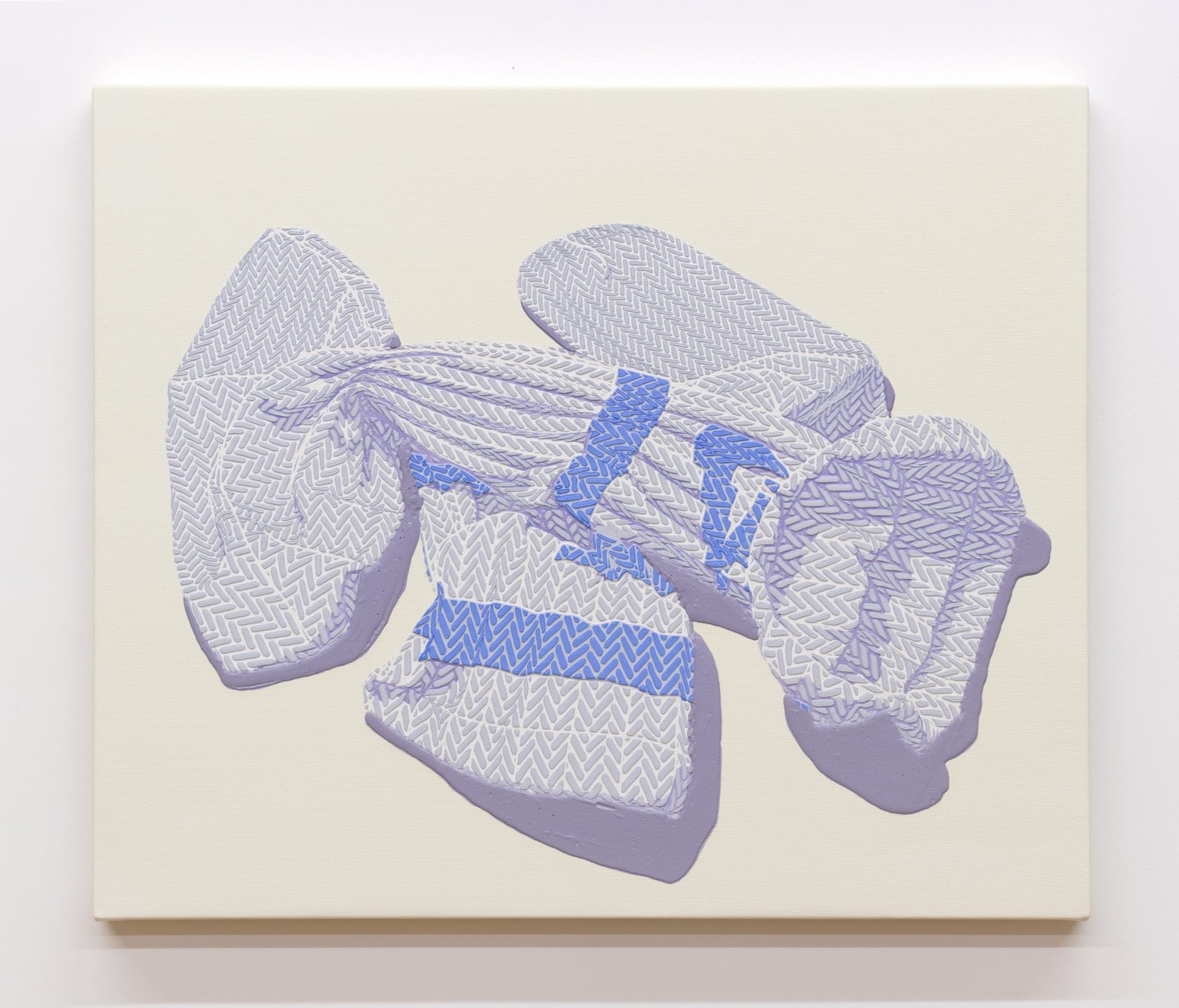
Soft Power for Hard Problems (Nike) I
2020
oil on canvas
38 x 45.5 cm
Maki Fine Arts is pleased to present Ordinary objects, a group show by Alex Dodge, Shoko Masunaga, Ryosuke Ogino, and Fuminao Suenaga, from November 27 through December 20, 2020. The four artists have chosen everyday ordinary objects as subject matter to showcase their unique approach to examining paintings.
Alex Dodge
Born 1977 in Denver, Colorado, Alex Dodge currently works from Brooklyn, New York, and Tokyo, Japan. His recent shows include Alex Dodge (solo, Klaus von Nichtssagend Gallery, 2020); The Trauma of Information (solo, Maki Fine Arts, 2019); Programmed: Rules, Codes, and Choreographies in Art, 1965-2018 (Whitney Museum of American Art, 2018-2019); and Whisper in My Ear and Tell Me Softly (solo, Klaus von Nichtssagend Gallery, 2018). His works have been added to collections at The Museum of Modern Art, Whitney Museum of American Art, The Metropolitan Museum of Art, and Museum of Fine Arts, Boston.
Shoko Masunaga
Born 1980 in Osaka, Japan, Shoko Masunaga graduated from Seian Zokei Junior College in 2000 with a major in painting. Her creative process originates from paintings and utilizes a variety of techniques. By focusing on connections to the surrounding environment and space, her works become fluid and interchangeable. Recent activities include the 2018-2019 NARS Foundation International Residency Program in Brooklyn, New York; Box, Box, Box (solo, Cooler Gallery, New York, 2019); CRITERIUM 93 Shoko Masunaga (solo, Gallery 9, Contemporary Art Gallery, Art Tower Mito, 2018); VOCA–The Vision of Contemporary Art 2017 (The Ueno Royal Museum); RURAN TADD PADAN-PADAN (solo, Gallery yolcha, Osaka, 2016); Platform (solo, LOOP HOLE, Tokyo, 2016); When I came home in the evening (milkyeast, Tokyo, 2016); This arrived in the post (IONIO&ETNA, Tokyo, 2015); Abstract Butter at HAGISO (solo, HAGISO, Tokyo, 2015); Where the three tables stand (Art Center Ongoing, 2015); and Medium Conditions (HAGISO, Tokyo, 2014).
Ryosuke Ogino
Born 1970 in Saitama, Japan, Ryosuke Ogino graduated from the School of Political Science and Economy at Meiji University in 1993 and completed the B-semi Learning System program in 1998. Ogino creates paintings using color layers while examining the relationship between color and form. Recent exhibitions include Absorption / Radiation (the 19th hokuto-building, Saitama, 2019); MOT Collection: Pleased to meet you. New Acquisitions in recent years (Museum of Contemporary Art Tokyo, 2019); Current Location of Paintings (Sapporo Odori 500-m Underground Walkway Gallery, Hokkaido, 2018); (-ness) (solo, Maki Fine Arts, 2018); Hello (solo, See Saw Gallery + Cafe, 2016); kotenten (solo, Switch Point, 2015); Present-Day Paintings: Two-Dimensional Works of Four Artists (Kawagoe City Art Museum, 2015); cannot see clearly (solo, gallery COEXIST-TOKYO, 2014); and New Vision Saitama 4 (The Museum of Modern Art, Saitama, 2011).
Fuminao Suenaga
Born 1974 in Yamagata, Japan, Fuminao Suenaga graduated from Tokyo Zokei University in 1999 with a major in painting. His paintings and three-dimensional works are based on visual subject matters inspired by elements relating to exhibition spaces as well as observations made during day-to-day activities. Recent shows include Picture Frame (solo, Maki Fine Arts, 2020); Publicness of the Art Center (Art Tower Mito, Contemporary Art Gallery, 2019-2020); Weavers of Worlds–A Century of Flux in Japanese Modern/Contemporary Art– (Museum of Contemporary Art Tokyo, 2019); MOT Collection: Pleased to meet you. New Acquisitions in recent years (Museum of Contemporary Art Tokyo, 2019); Search Results (solo, Maki Fine Arts, Tokyo, 2018); railroad siding 2017 (former Tokorozawa city supply center for school meals, Saitama, 2017); APMoA Project ARCH vol. 11 Museum Piece (Aichi Prefecture Museum of Art, 2014); and Born in 1974 (part 1 of a 40th anniversary show, Museum of Modern Art, Gunma, 2014).
Fuminao Suenaga : Picture Frame

Picture Frame
2020
Acrylic, pigment, gold paint on cotton and panel
51.3 x 41.8 x 5.5cm
Maki Fine Arts is pleased to present Picture Frame, a solo show by Fuminao Suenaga, to celebrate the gallery’s 10th anniversary, starting Saturday, August 29, 2020. The exhibition will showcase new works from Suenaga’s “Picture Frame” series, depicting the frames that surround existing masterpiece paintings. When the series was first shown at Aichi Prefectural Museum of Art in 2014, his works portrayed picture frames from the museum’s own collection. In his much-awaited fourth solo show at Maki Fine Arts, Suenaga has focused on celebrated paintings he has seen in person or has researched online.
—
Creating Intimacy: Fuminao Suenaga Picture Frame
Yoko Nose (curator, Toyota Municipal Museum of Art)
Without a trace of contradiction, his works unite cuteness–the type that can be found in the embellishments on a box of sweets–and conceptualism–demonstrated through the minimalistic reliefs used in his works. The slick, two-dimensional surfaces help us glide past any thoughts of reading too much into them. What you see aligned on the walls are paintings that are part of a museum’s collection: museums such as The Museum of Modern Art, The Metropolitan Museum of Art, The National Museum of Western Art (Tokyo), and Aichi Prefectural Museum of Art.
Although they are depictions of paintings, only the frames are clearly outlined. The paintings themselves are gone, replaced by a single color. Yet they are not completely erased. The “empty” sections evenly fill the entire box-like surface, morphing into something completely different. The original frames selected for inspiration have wood mosaic applications, simple straight lines, or leaf- or geometric-shaped reliefs. When a painting’s surface is void of any color or tone, the original work’s individuality is completely sanitized, including the time period in history, philosophical isms behind the work, as well as the historical events that inspired the creation of the piece. When this happens, the frame–normally relegated to a utilitarian function or, at most, a sidekick that brings out the best of the main character–now becomes equal to or perhaps even outshines the painting itself.
In the past, paintings were literally part of the building, integrated onto the wall. The use of picture frames originated from a need to take the paintings off the wall surface to transport them. The frames showcased in Picture Frame are unimposing, all small enough to be carried anywhere. They resemble furniture, creating intimacy and freedom in the space. The fabricated feel that comes from imitating the original helps curb explicit exaggeration of the painting’s worth. Yet, Picture Frame also solicits a light pondering. What is painting?
—
Fuminao Suenaga
Born 1974 in Yamagata, Japan, Fuminao Suenaga graduated from Tokyo Zokei University in 1999 with a major in painting. His paintings and three-dimensional works are based on visual subject matters inspired by elements relating to exhibition spaces and observations made during day-to-day activities. Recent shows include Publicness of the Art Center (Art Tower Mito, Contemporary Art Gallery, 2019-2020), Weavers of Worlds -A Century of Flux in Japanese Modern/Contemporary Art– (Museum of Contemporary Art Tokyo, 2019), Pleased to meet you. New Acquisitions in recent years (Museum of Contemporary Art Tokyo, 2019), Search Results (Maki Fine Arts, Tokyo, 2018), railroad siding 2017 (former Tokorozawa city supply center for school meals, Saitama, 2017), The Potential of Intangible Art Vol. 3 Transform / Paint (with Yui Yaegashi, gallery αM, 2016), Maki Fine Arts 5th anniversary group show discreet abstraction (curator, Maki Fine Arts, 2015), APMoA Project ARCH vol. 11 Museum Piece (Aichi Prefecture Museum of Art, 2014), and Born in 1974 (part 1 of a 40th anniversary show, Museum of Modern Art, Gunma, 2014).

